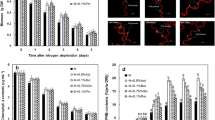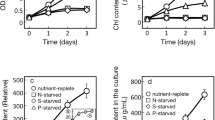Abstract
Synechococcus sp. MA19, grown autotrophically under phosphate-limited conditions at 50 °C, produced poly-β-hydroxybutyrate (PHB) when intracellular phosphate content was 0.043–0.076mmol per g of cellular components. In the culture for 260h using Ca3(PO4)2 as a phosphate source, strain MA19 accumulated PHB at 55% (w/w) of the dry cells and the amount of PHB produced was 2.4gl−1 which was almost twice that without Ca3(PO4)2 addition.
Similar content being viewed by others
References
Brandl H, Gross RA, Lenz RW, Fuller RC (1990) Plastics from bacteria and for bacteria: poly(beta-hydroxyalkanoates) as natural, biocompatible, and biodegradable polyesters. Adv. Biochem. Eng. Biotechnol. 41: 77–93.
Braunegg G, Sonnleitner B, Lafferty RM (1987) A rapid gas chromatographic method for the determination of poly-β-hydroxybutyric acid in microbial biomass. Eur. J. Appl. Microbiol. 6: 29–37.
Campbell III J, Stevens Jr SE, Balkwill DL (1982) Accumulation of poly-β-hydroxybutyrate in Spirulina plantensis. J. Bacteriol. 149: 361–363.
De Philippis R, Ena A, Guastini M, Sili C, Vincenzini M (1992a) Factors affecting poly-β-hydroxybutyrate accumulation in cyanobacteria and in purple non-sulfur bacteria. FEMS Microbiol. Rev. 103: 187–194.
De Philippis R, Sili C, Vincenzini M (1992b) Glycogen and poly-β-hydroxybutyrate synthesis in Spirulina maxima. J. Gen. Microbiol. 138: 1623–1628.
Ishizaki A, Tanaka K (1991) Production of poly-β-hydroxybutyric acid from carbon dioxide by Alcaligenes eutrophus ATCC17697. J. Ferment. Bioeng. 4: 254–257.
Miyake M, Erata M, Asada Y (1996) A thermophilic cyanobacterium, Synechococcus sp. MA19, capable of accumulating poly-β-hydroxybutyrate. J. Ferment. Bioeng. 82: 512–514.
Rippka R, Deruelles J, Waterbury JB, Herdman M, Stanier RY (1979) Genetic assignments, strain histories and properties of pure cultures of cyanobacteria. J. Gen. Microbiol. 111: 1–61.
Stal LJ (1992) Poly(hydroxyalkanoate) in cyanobacteria: an overview. FEMS Microbiol. Rev. 103: 169–180.
Takahashi T, Miyake M, Tokiwa Y, Asada Y (1998) Improved accumulation of poly-3-hydroxybutyrate by a recombinant cyanobacterium. Biotechnol. Lett. 20: 183–186.
Umbreit WW, Burris RM, Stauffer JF (1957) Manometric Techniques-A Manual Describing Methods Applicable to the Study of Tissue Metabolism. Minneapolis: Burgess Publishing, pp. 238–291.
Vincenzini M, Sili C, De Philippis R, Ena A, Materassi R (1990) Occurrence of poly-β-hydroxybutyrate in Spirulina species. J. Bacteriol. 172: 2791–2792.
Author information
Authors and Affiliations
Corresponding author
Rights and permissions
About this article
Cite this article
Nishioka, M., Nakai, K., Miyake, M. et al. Production of poly-β-hydroxybutyrate by thermophilic cyanobacterium, Synechococcus sp. MA19, under phosphate-limited conditions. Biotechnology Letters 23, 1095–1099 (2001). https://doi.org/10.1023/A:1010551614648
Issue Date:
DOI: https://doi.org/10.1023/A:1010551614648




